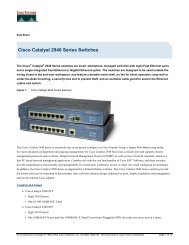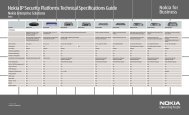Cisco Catalyst 2960 Series Switches - ESC Electronic Service Center
Cisco Catalyst 2960 Series Switches - ESC Electronic Service Center
Cisco Catalyst 2960 Series Switches - ESC Electronic Service Center
You also want an ePaper? Increase the reach of your titles
YUMPU automatically turns print PDFs into web optimized ePapers that Google loves.
Table 1. Features and Benefits of <strong>Cisco</strong> <strong>Catalyst</strong> <strong>2960</strong> <strong>Series</strong><br />
Feature Benefit<br />
Ease of Use and<br />
Deployment<br />
Availability and Scalability<br />
Superior<br />
Redundancy for<br />
Fault Backup<br />
Integrated <strong>Cisco</strong><br />
IOS ® Software<br />
Features for<br />
Bandwidth<br />
Optimization<br />
Data Sheet<br />
Express Setup simplifies initial configuration with a Web browser, eliminating the need for more<br />
complex terminal emulation programs and CLI knowledge.<br />
DHCP autoconfiguration of multiple switches through a boot server eases switch deployment.<br />
Automatic QoS (Auto QoS) simplifies QoS configuration in voice-over-IP (VoIP) networks by<br />
issuing interface and global switch commands to detect <strong>Cisco</strong> IP phones, classify traffic, and<br />
enable egress queue configuration.<br />
Autosensing on each 10/100 port detects the speed of the attached device and automatically<br />
configures the port for 10- or 100-Mbps operation, easing switch deployment in mixed 10- and<br />
100-Mbps environments.<br />
Autonegotiating on all ports automatically selects half- or full-duplex transmission mode<br />
to optimize bandwidth.<br />
Dynamic Trunking Protocol (DTP) helps enable dynamic trunk configuration across all switch<br />
ports.<br />
Port Aggregation Protocol (PAgP) automates the creation of <strong>Cisco</strong> Fast EtherChannel ® groups<br />
or Gigabit EtherChannel groups to link to another switch, router, or server.<br />
Link Aggregation Control Protocol (LACP) allows the creation of Ethernet channeling with<br />
devices that conform to IEEE 802.3ad. This feature is similar to <strong>Cisco</strong> EtherChannel<br />
technology and PAgP.<br />
DHCP Server enables a convenient deployment option for the assignment of IP addresses in<br />
networks that do not have without a dedicated DHCP server.<br />
DHCP Relay allows a DHCP relay agent to broadcast DHCP requests to the network DHCP<br />
server.<br />
1000BASE-SX, 1000BASE-LX/LH, 1000BASE-ZX, 1000BASE-BX, 100BASE-FX, 100BASE-<br />
LX, 100BASE-BX, and coarse wavelength-division multiplexing (CWDM) physical interface<br />
support through a field-replaceable SFP module provides unprecedented flexibility in switch<br />
deployment.<br />
The default configuration stored in flash memory ensures that the switch can be quickly<br />
connected to the network and can pass traffic with minimal user intervention.<br />
Automatic medium-dependent interface crossover (Auto-MDIX) automatically adjusts transmit<br />
and receive pairs if an incorrect cable type (crossover or straight-through) is installed on a<br />
copper port.<br />
Time-domain reflectometer (TDR) to diagnose and resolve cabling problems on copper ports.<br />
<strong>Cisco</strong> UplinkFast and BackboneFast technologies help ensure quick failover recovery,<br />
enhancing overall network stability and reliability.<br />
IEEE 802.1w Rapid Spanning Tree Protocol provides rapid spanning-tree convergence<br />
independent of spanning-tree timers and the benefit of distributed processing.<br />
Per-VLAN Rapid Spanning Tree Plus (PVRST+) allows rapid spanning-tree reconvergence<br />
on a per-VLAN spanning-tree basis, without requiring the implementation of spanning-tree<br />
instances.<br />
Command-switch redundancy enabled in <strong>Cisco</strong> Network Assistant software allows designation<br />
of a backup command switch that takes over if the primary command switch fails.<br />
Unidirectional Link Detection Protocol (UDLD) and Aggressive UDLD allow unidirectional links<br />
to be detected and disabled to avoid problems such as spanning-tree loops.<br />
Switch port autorecovery (errdisable) automatically attempts to re-enable a link that is disabled<br />
because of a network error.<br />
<strong>Cisco</strong> Redundant Power System 675 (RPS 675) support provides superior internal powersource<br />
redundancy for up to six <strong>Cisco</strong> networking devices, resulting in improved fault tolerance<br />
and network uptime.<br />
Bandwidth aggregation up to 8 Gbps through <strong>Cisco</strong> Gigabit EtherChannel technology and up to<br />
800 Mbps through <strong>Cisco</strong> Fast EtherChannel technology enhances fault tolerance and offers<br />
higher-speed aggregated bandwidth between switches and to routers and individual servers.<br />
Per-port broadcast, multicast, and unicast storm control prevents faulty end stations from<br />
degrading overall systems performance.<br />
IEEE 802.1d Spanning Tree Protocol support for redundant backbone connections and loopfree<br />
networks simplifies network configuration and improves fault tolerance.<br />
PVST+ allows for Layer 2 load sharing on redundant links to efficiently use the extra capacity<br />
inherent in a redundant design.<br />
IEEE 802.1s Multiple Spanning Tree Protocol allows a spanning-tree instance per VLAN,<br />
enabling Layer 2 load sharing on redundant links.<br />
Egress committed rate (ECR) guarantee provides load balancing and redundancy.<br />
Local Proxy Address Resolution Protocol (ARP) works in conjunction with Private VLAN Edge<br />
to minimize broadcasts and maximize available bandwidth.<br />
VLAN1 minimization allows VLAN1 to be disabled on any individual VLAN trunk link.<br />
VLAN Trunking Protocol (VTP) pruning limits bandwidth consumption on VTP trunks by<br />
flooding broadcast traffic only on trunk links required to reach the destination devices.<br />
All contents are Copyright © 1992–2007 <strong>Cisco</strong> Systems, Inc. All rights reserved. This document is <strong>Cisco</strong> Public Information. Page 6 of 14







